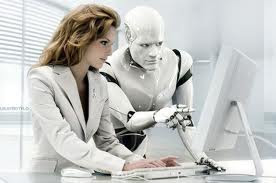
Tuesday, February 21, 2012

(federico pistono)
You are about to become obsolete. You think that you are special, unique, and that whatever it is that you are doing is impossible to replace. You are wrong.
As we speak, millions of algorithms created by computer scientists are frantically running on servers all over the world with one sole purpose: do whatever we used to do, but better. These algorithms are intelligent computer programs, permeating the substrateof our society. They make financial decisions, they predict the weather, they suggest which countries will wage war next. Soon, there will be little left for us to do: machines will take over.
Does that sound like a futuristic fantasy? Maybe so. This argument is proposed by a growing, yet still fringe, community of thinkers, scientists and academics, who see the advancement of technology as a
disruptive force which will soon transform our entire socio-economic system, forever. According to them, the displacement of labour by machines and computer intelligence will increase dramatically over the next decades. Such changes will be so drastic and quick that the market will not be able to abide in creating new opportunities for workers who lost their job, making unemployment not just part of a cycle, but structural in nature and chronically irreversible. It will be the end of work as we now it.
Most economists discard such arguments. Many of them don’t even address the issue in the first place. And those who do claim that the market always finds a way. As old jobs are replaced by machines, new jobs are created. Thanks to the ingenuity of the human mind and the need for growth, markets always find a way, especially in the ever-connected and globalized mass-market we live in today.
I don’t think we should approach this issue based on our beliefs, hunches, or gut feeling. Rather, let’s use logic and reason based on the evidence that we have so far.
Consider this. The exponential expansion of technology has been growing remarkably smoothly for a long time. And I’m not referring to the well-known Moore’s law, which states that the number of transistors that can be placed on an integrated circuit doubles approximately every two years. Integrated circuits are just a tiny fraction of the whole spectrum of change that pervades technological advancement.
Kurzweil notes that Moore’s Law was not the first to do so, but rather the fifth paradigm to provide accelerating price-performance. Computing devices have been consistently multiplying in power (per unit of time),
from the mechanical calculating devices used in the 1890 U.S. Census, to Turing’s relay-based “Robinson” machine that cracked the Nazi enigma code, to the CBS vacuum tube computer that predicted the election of Eisenhower, to the transistor-based machines used in the first space launches, to the integrated-circuit-based personal computer which Kurzweil used to dictate the very essay that described this phenomenon in 2001...
(more)
0 Comments:
